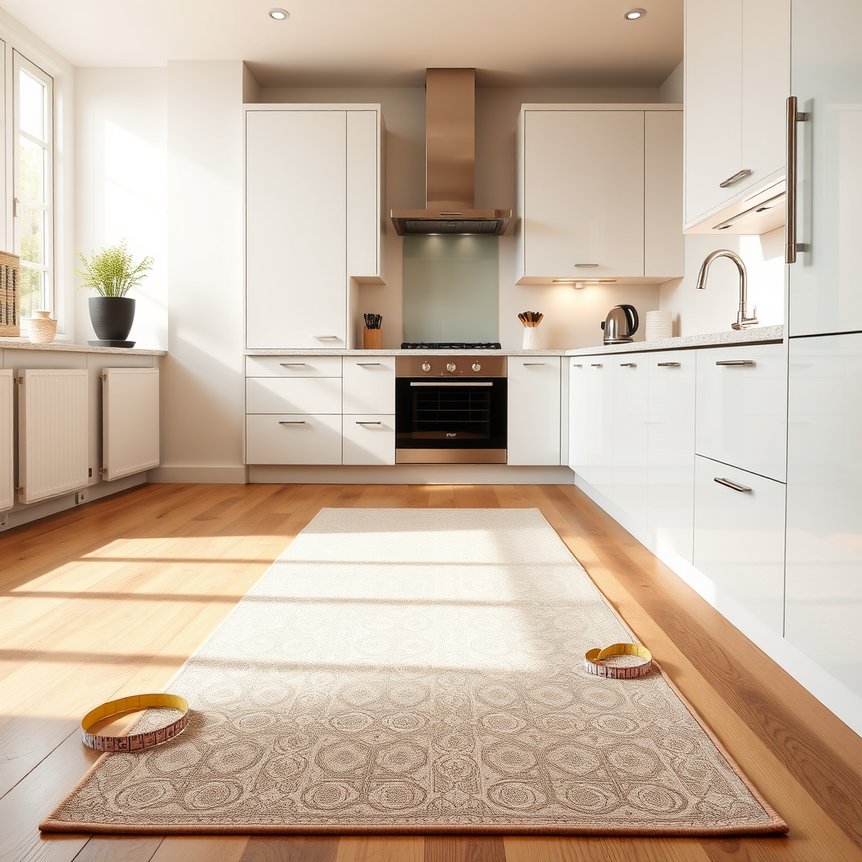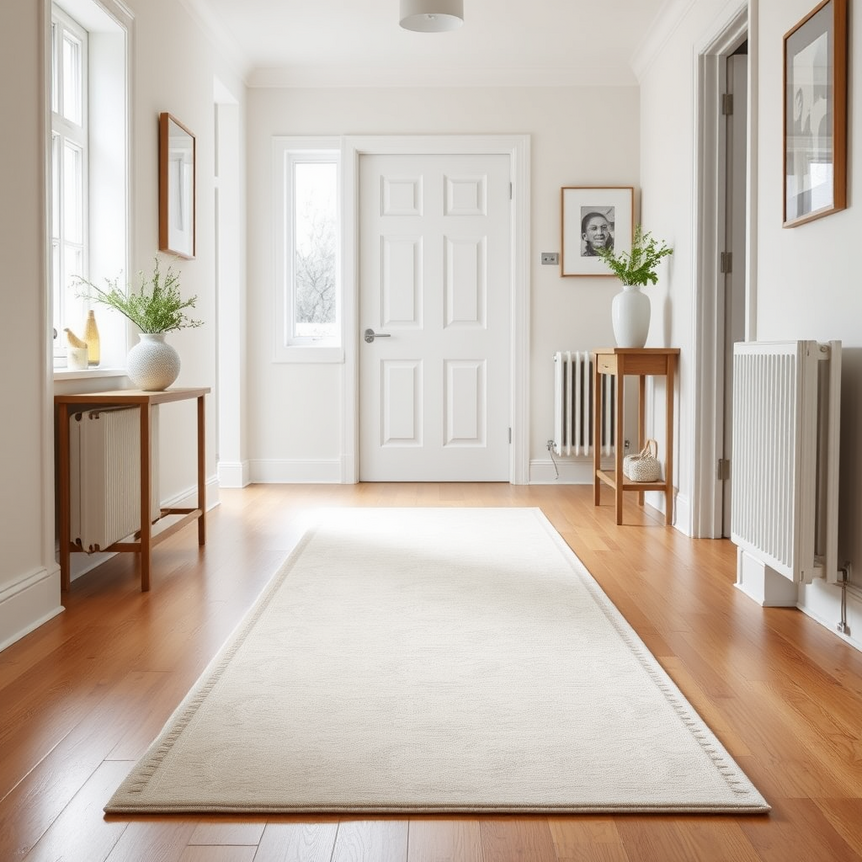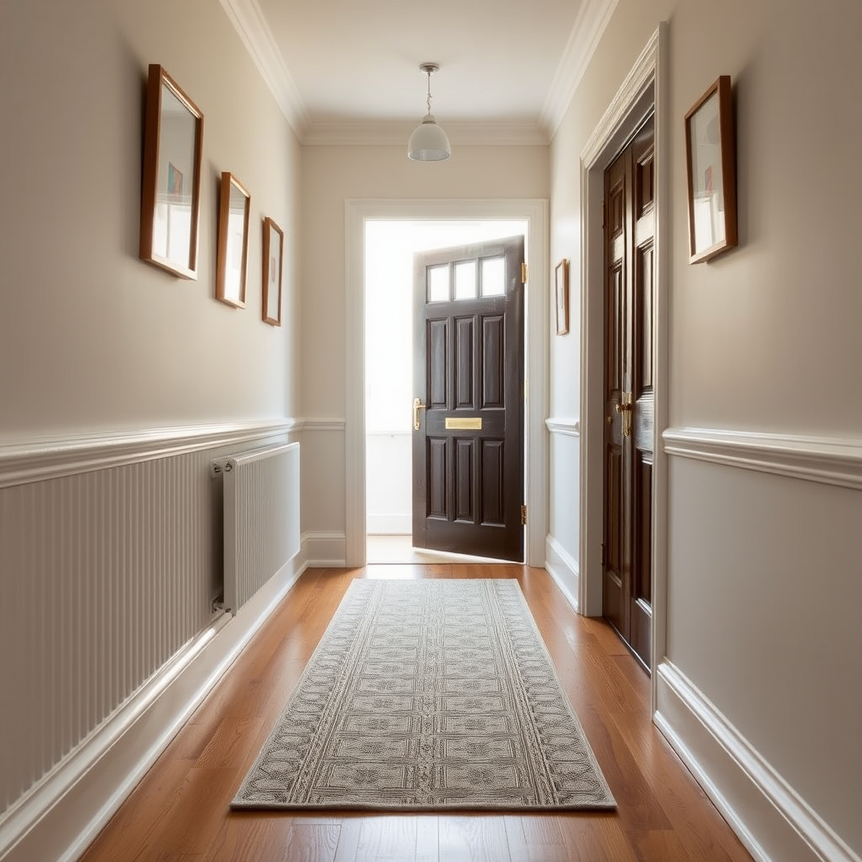Choosing the right kitchen runner rug size is essential to blend function, safety, and style in your UK kitchen. This comprehensive guide will walk you through understanding typical UK kitchen layouts, how to measure accurately, the standard sizes available, and expert tips for selecting and styling the perfect runner to enhance your home.
1. Choosing the Ideal Kitchen Runner Rug Size for UK Kitchens
Understanding UK Kitchen Layouts and Common Dimensions
UK kitchens often present unique challenges and opportunities due to their diverse architectural styles, ranging from compact, space-efficient galley kitchens common in terraced homes and flats, to more expansive L-shaped or U-shaped layouts found in semi-detached or detached properties. Standard widths for walkways typically fall between 90cm and 120cm, making the selection of an appropriately sized kitchen runner rug crucial. Recognising your kitchen’s specific configuration—whether it’s a bustling family hub or a sleek, minimalist space—is the first step in ensuring your runner fits seamlessly without overwhelming or underutilising the area. Understanding these common dimensions will guide you in choosing a runner that complements your kitchen’s natural flow and aesthetic.
Why Size Matters for Kitchen Runners: Function and Aesthetics
The kitchen runner rug size you choose significantly impacts both the practical utility and the visual appeal of your space. A well-sized kitchen runner provides invaluable comfort underfoot, particularly in high-traffic zones like in front of the sink or stove, where you spend prolonged periods standing. Beyond comfort, it acts as a vital protective barrier for your flooring against spills, drops, and daily wear and tear. When a rug is too narrow or short, it can appear visually disproportionate, fail to adequately protect the floor, and look out of place. Conversely, a runner that is too wide or excessively long can become a serious trip hazard, obstruct the opening of cabinet doors and appliances, or make the kitchen feel cramped and cluttered. The ideal kitchen runner rug size strikes a perfect balance, offering excellent floor protection, enhancing safety, and elevating the overall design harmony of your kitchen.
2. How to Measure Your Kitchen Space Accurately
Step-by-Step Guide to Measuring Kitchen Floors for Runners
Accurate measurement is paramount to finding the perfect kitchen runner rug size. Follow these steps to ensure a precise fit:
- Clear the Area: Begin by removing any obstacles, small rugs, or clutter from the kitchen floor where you intend to place the runner. This ensures you can take precise, unobstructed measurements.
- Measure Length: Using a reliable tape measure, determine the length of the walkway or the specific area where the runner will lie, typically between cabinetry or along an aisle. Measure from wall to wall, or from cabinet face to cabinet face.
- Measure Width: Next, measure the width of the space. This is crucial for ensuring the runner doesn’t touch the sides of your cabinets or walls. Remember to leave a comfortable clearance—ideally at least 10-15cm (4-6 inches) on each side of the runner. This ensures safe passage and prevents the rug from buckling or becoming a tripping hazard.
Tips for Accounting for Cabinetry, Appliances, and Walkways
When selecting your kitchen runner rug size, several practical considerations must be kept in mind:
- Appliance and Drawer Clearance: Always ensure that the chosen runner’s width and placement allow all drawers, appliance doors (like dishwashers and ovens), and cupboard doors to open fully without obstruction or snagging the rug.
- Spill Zones: While runners protect floors, consider the material carefully if placing them directly in high-spill zones (e.g., directly under a sink prone to splashes). Opt for materials that are explicitly waterproof or exceptionally easy to clean.
- Doorways and Transitions: Avoid letting the runner extend too close to kitchen entrances or transitions to other rooms. This prevents the rug from becoming a tripping hazard or being caught by opening doors. A clear margin helps maintain a smooth flow between spaces.
- Multiple Areas: If your kitchen has multiple high-traffic zones (e.g., in front of the sink and stove), consider using two smaller, complementary runners rather than one excessively long one, ensuring each kitchen runner rug size is optimal for its specific location.
3. Standard Kitchen Runner Rug Sizes Available in the UK Market
The UK market offers a range of standard kitchen runner dimensions designed to fit various kitchen layouts. Understanding these common sizes is crucial when considering your ideal kitchen runner rug size.
Overview of Typical Runner Lengths and Widths
In the UK, common kitchen runner sizes typically include:
- Widths: 60cm (approx. 2 ft), 70cm (approx. 2.3 ft), 80cm (approx. 2.6 ft)
- Lengths: 120cm (approx. 4 ft), 180cm (approx. 6 ft), 240cm (approx. 8 ft), and 300cm (approx. 10 ft)
These dimensions are designed to accommodate the majority of kitchen aisles and workflow paths. For narrower kitchens, a 60cm x 180cm runner often suffices, while larger kitchens may suit a wider 70-80cm runner that extends longer for more comprehensive coverage.
Matching Rug Dimensions to Different Kitchen Shapes and Sizes
Selecting the right kitchen runner rug size is about more than just measurements; it’s about harmonising with your kitchen’s unique shape:
- Galley Kitchens: These narrow, often long kitchens benefit immensely from a single, elongated runner. Opt for a narrow but long kitchen runner rug size, such as ~60cm x 240cm or even 300cm, to fit snugly within the aisle without crowding. This creates a continuous path, enhancing both comfort and visual length.
- L-shaped or U-shaped Kitchens (with or without an island): Instead of one large rug, consider using shorter, strategically placed runners to zone specific areas where prolonged standing occurs. For instance, a 60cm x 120cm or 70cm x 180cm rug placed in front of the sink, stove, or main prep area can offer targeted comfort and protection without disrupting the kitchen’s flow.
- Open-Plan Kitchens: In kitchens that flow into dining or living areas, the kitchen runner can serve as a subtle demarcation. Consider using a larger runner that complements adjoining spaces for continuity, or layer multiple smaller runners that visually link the kitchen area while maintaining an open feel. The key is to choose dimensions that help define the kitchen zone without isolating it.
Kitchen Runner Rug Size Guide: UK Standard Dimensions
To help you visualise and select the perfect fit, here’s a quick guide to common kitchen runner rug sizes and their ideal applications in UK homes:
| Kitchen Runner Size (Approx. UK Standard) | Ideal Kitchen Layout/Area | Key Benefit |
|---|---|---|
| 60cm x 120cm (Small) | Small kitchens, in front of a single appliance (sink, stove, dishwasher). | Targeted comfort, floor protection in high-spill zones, easy to move/clean. |
| 60cm x 180cm (Medium) | Narrow galley kitchens, short aisles, between a counter and island. | Extends comfort along a short path, good for smaller footprints. |
| 70cm x 240cm (Large) | Longer galley kitchens, central aisles in medium-sized kitchens. | Covers a significant portion of a main walkway, offering continuous comfort. |
| 80cm x 300cm (Extra Large) | Very long or wider kitchen aisles, open-plan kitchen zones. | Maximises coverage and defines large kitchen areas, grand visual impact. |
4. Balancing Style and Practicality: Selecting the Right Runner Width and Length
How Rug Size Impacts Kitchen Workflow and Safety
The kitchen runner rug size plays a pivotal role in ensuring a smooth and safe kitchen environment. Choosing a runner width that is too wide for your aisle can significantly encroach upon valuable walkway space, creating an unnecessary tripping hazard and making it difficult to move freely. Similarly, a runner that is too long and extends into doorways or across high-traffic intersections can also pose a risk. Conversely, a well-chosen runner improves comfort during essential cooking and washing tasks, providing a soft, supportive surface underfoot. It should cover the primary high-use zones—like in front of the sink, hob, or prep area—but stop short of obstructing any natural pathways or door swings. A correctly sized runner seamlessly integrates into your kitchen, enhancing both functionality and safety without disrupting the natural flow of movement.
Enhancing Décor with the Appropriate Runner Size
Beyond its practical benefits, the kitchen runner also serves as a significant décor element, capable of transforming the visual appeal of your space. The length and width you select can effectively frame kitchen zones, adding texture, pattern, and a pop of colour to your design scheme. For instance, a brightly patterned runner sized perfectly for a specific area, such as in front of a large prep counter, can serve as a focal point, drawing the eye and adding warmth to an otherwise minimalist kitchen. A long, narrow runner in a galley kitchen can visually elongate the space, creating an inviting pathway. The right kitchen runner rug size can tie together disparate elements, add personality, and make your kitchen feel more inviting and complete.
5. Material and Texture Considerations for Kitchen Runners of Different Sizes
Choosing Materials That Complement Runner Length and Kitchen Traffic
When selecting your kitchen runner rug size, the material and texture are just as important as the dimensions, especially given the unique demands of a kitchen environment. Different materials are better suited for different runner lengths and varying levels of kitchen traffic:
-
- Shorter Runners for High-Traffic Zones: For compact runners placed in front of sinks, stoves, or dishwashers—areas prone to spills and heavy footfall—opt for highly durable, stain-resistant, and easy-to-clean fibres. Materials like polypropylene, synthetic blends, or robust flatweave rugs are excellent choices. They withstand daily wear and tear, repel moisture, and can be spot-cleaned or machine-washed with ease.
-
- Long Runners for Extended Coverage: When selecting long runners that cover extended aisles, it’s crucial that they feature a high-quality non-slip backing to prevent shifting and potential accidents. Look for washable textures and low-pile constructions that resist dirt accumulation and are quick to dry in case of spills. Natural fibres like jute or sisal can offer a beautiful, organic look for lower-traffic areas, but synthetic options often provide superior durability and stain resistance for the bustling UK kitchen.
Maintenance Tips for Common Kitchen Runner Sizes
To ensure your kitchen runner remains hygienic and looks its best, consider these maintenance tips:
-
- Easy Cleaning: Regardless of the kitchen runner rug size, choose rugs that can be easily cleaned in-situ with a vacuum or spot-cleaned, or conveniently removed for a more thorough wash. Many modern kitchen runners are machine washable, a significant advantage for busy households.
-
- Low-Pile/Flatweave: Opt for low-pile or flatweave rugs. Their construction resists dirt and debris from becoming deeply embedded, making them easier to vacuum and preventing mould or mildew growth from spills, especially important for longer runners that might take more effort to move.
-
- Regular Care: Vacuum your kitchen runner regularly, ideally daily in high-traffic kitchens, to remove crumbs and dirt. Address spills immediately to prevent staining, using appropriate cleaning solutions for your rug material.
For durable and practical options designed to withstand the rigours of UK kitchens with heavy footfall and frequent spills, explore the Heavy Duty Kitchen Runner Rug, available at RugStars.co.uk. This product offers superior resilience and easy maintenance, making it an ideal choice for busy households.
6. Expert Tips for Placing and Styling Your Runner Rug Perfectly
Positioning Runners for Maximum Impact and Comfort
The placement of your kitchen runner is just as important as choosing the correct kitchen runner rug size. Strategic positioning can greatly enhance both the functionality and aesthetics of your kitchen:
-
- Target High-Use Zones: Place runners primarily in front of areas where you spend the most time standing – typically the sink, dishwasher, and cooking range. This provides cushioned comfort, reduces fatigue during prolonged tasks, and protects the floor from splashes and dropped items.
-
- Centre the Runner: For a balanced and aesthetically pleasing look, centre your runner in the kitchen aisle. Aim for equal spacing from the cabinetry edges on both sides. This creates a clear pathway and visually anchors the space.
-
- Avoid Obstructions: Ensure the runner does not impede the full opening of any doors (including pantry doors or appliance doors) or drawers. There should be sufficient clearance for smooth operation.
-
- Consider Traffic Flow: Think about how people move through your kitchen. The runner should guide traffic, not obstruct it. Avoid placing it in chaotic intersections where it might shift or create a tripping hazard.
Layering and Coordinating with Other Kitchen Textiles
Elevate your kitchen’s style by coordinating your runner with other textiles and décor elements:
-
- Cohesive Colour Palettes: Select rug patterns and colours that harmonise with your kitchen towels, seat cushions, curtains, or even wall art. This creates a cohesive and well-thought-out design scheme. For example, if your kitchen features cool tones, a runner with subtle blues or greys can complement beautifully.Read our guide on Popular Colors Of Hallway Runners For UK Homes
-
- Layering for Comfort and Durability: In kitchens with distinct activity zones, consider layering smaller, highly durable mats directly in front of the sink or stove over a longer, coordinating runner. This adds an extra layer of comfort and protection in key spots while allowing for easier cleaning of the smaller, more frequently soiled mats.
-
- Introduce Texture: Use the runner to introduce varied textures into your kitchen. A flatweave runner can provide a sleek, modern look, while a slightly more textured option can add warmth and depth to a rustic or traditional kitchen.
7. Frequently Asked Questions
Q: What is the best width for a kitchen runner rug?
A: The ideal width for a kitchen runner rug in the UK is typically between 60cm and 80cm. The best choice depends on your kitchen aisle’s width, ensuring you maintain at least 10-15cm (4-6 inches) of clear flooring on each side of the runner for safe movement and a balanced aesthetic.
Q: Can I use a runner rug in a small UK kitchen?
A: Absolutely! Runner rugs are particularly beneficial in small UK kitchens. Choose a narrower (60cm) and shorter runner (up to 180cm) to add comfort, floor protection, and a touch of style without overcrowding the limited space. Accurate measuring is key.
Q: How much rug should extend beyond kitchen furniture?
A: For safety and functionality, a kitchen runner should ideally not extend beyond kitchen furniture or cabinetry. Aim for a clearance of 10-15cm (4-6 inches) from cabinet fronts, appliances, or walls to prevent tripping hazards and allow doors and drawers to open freely.
Q: What runner length works best for galley kitchens?
A: For galley kitchens, a long kitchen runner rug size of around 240cm to 300cm works exceptionally well. This length allows the runner to cover most of the central aisle, enhancing both comfort and flooring protection along the primary workspace. Always measure your specific galley kitchen to find the perfect fit.
Q: Are there special considerations for rug sizing in open-plan kitchens?
A: Yes, in open-plan kitchens, your chosen kitchen runner rug size and style should contribute to defining the kitchen zone without interrupting the overall flow of the larger space. Opt for sizes and patterns that either complement or subtly contrast with adjoining living/dining areas, and avoid placing runners in natural pathways between different functional zones.
By measuring carefully and considering the interplay of size, material, and position, your kitchen runner rug can provide enduring style and invaluable function. For high-quality, durable, and UK-sized options designed specifically for busy kitchen environments, explore the Heavy Duty Kitchen Runner Rug available at RugStars.co.uk. Invest in a runner that not only looks great but also performs exceptionally in the heart of your home.



